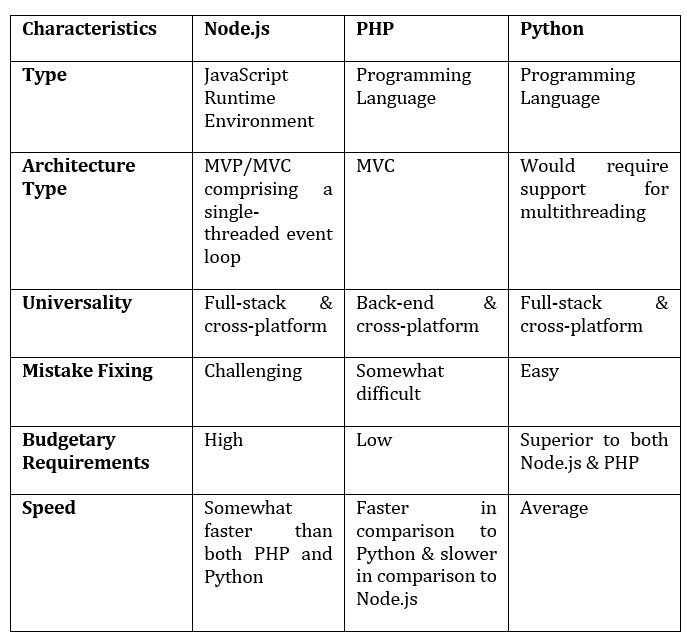Is Node.js Killing Python and PHP? (A must Read For Developers)
Three of the most popular technologies powering the backend of web applications are PHP, Python, and Node.js. Of these three, Python is the oldest one introduced in 1991, while PHP has dominated the industry for 20+ years now. On the other hand, despite being a relatively newbie, Node.js released in 2009 is swiftly rising to the top of the list of developers’ favorite technologies.
PHP and JavaScript were thought of as vastly dissimilar technologies throughout the 1990s and the early 2000s. The former would take care of the “brains,” whilst the latter would be utilized to modify the DOM and build dynamic web pages that look appealing.
Eventually, programmers began considering JavaScript as a general-purpose language. Its syntax and adaptability made it an excellent choice for novice developers to start creating applications and scripts rapidly. Node.js was created in this way, and overnight the frontend-focused language transformed into a one-stop shop for web development.
However, a lot of people think that Python and PHP are being replaced by Node. In this blog, we will go into detail as to what the features of Node.js, Python, and PHP are and whether Node.js is gradually killing Python and PHP.
What is Node.js?
Node. js is an open-source development platform for executing JavaScript code server-side. The enormous collection of JavaScript modules it provides makes creating web apps easier.
Since JavaScript can be used to create both the server and client sides of an application, many programmers find Node.JS to be more user-friendly. Additionally, Node.js runs asynchronous code on the server. With this, it accelerates server performance and increases its capacity to handle more requests.
Take a look at some of the interesting statistics about Node.js:
- Loading times can be reduced by 50%–60% with Node JS.
- The cost of developing is reduced by 58% while utilizing Node JS.
- 36.42% of seasoned developers use libraries, frameworks, and tools from the Node JS ecosystem.
- 85% of JavaScript students appreciate how easily accessible the procedure is. 71% of JavaScript students think the instructional resources are excellent.
- Node JS is downloaded most frequently for Linux (78%), followed by Windows (17%), and macOS (5%).
What is Python?
Python is a general-purpose, object-oriented programming language that is often used to build websites and software, analyze data, and automate procedures. As a result, it is not restricted to server programming and the backend web.
For instance, Python is frequently used to develop machine learning algorithms. Additionally, Python can be used for a wide range of tasks in web design, such as routing URLs, database connections, data transmission to and from services, and many more.
Some of the compelling Python statistics:
- Python Statistics 2020 lists Python as one of the top programming languages in the world.
- According to statistics, employment in the Python industry is expanding. While Glassdoor now has over 90,000 postings, Indeed currently shows over 70,000 jobs available!
- A Python developer might make up to $118,000 in a year.
- One of Google’s recognized official languages is Python.
- The Python package repository contains 147,000 packages!
What is PHP?
PHP is one of the most widely used server-side programming languages and the most common Node.js replacement. The name of the language originally meant Personal Home Page. A recursive abbreviation for PHP: Hypertext Preprocessor eventually developed.
Despite significant criticism of its architecture, PHP has become one of the most popular website creation tools. A general-purpose language is PHP. As a result, it can be used in various situations. For instance, PHP code is present in HTML and may be used with a variety of content management systems, strong frameworks, and themes.
Take a look at the following statistics of PHP:
- Of all the websites whose server-side programming language we are aware of, PHP is used by 77.5% of them.
- The most popular server-side programming language on the internet is PHP. In fact, PHP is used in some capacity by 79.2% of all websites, making it one of the most well-liked programming languages among programmers and web developers.
Comparison between Node.js, PHP, and Python
The main characteristics of each of these three frameworks are listed below. This will aid in your comprehension of the main distinctions between the various technologies.
What are the key features of Node.js?
- Asynchronous and Event-driven: Node.js is designed to handle asynchronous programming tasks, meaning it can handle many tasks simultaneously without waiting for each other to complete. It uses an event-driven architecture, which means it waits for an event to occur and then executes a callback function.
- Cross-platform: Node.js is cross-platform, meaning it can run on Windows, macOS, and Linux operating systems.
- Fast and Scalable: Unlike traditional web servers that create a new thread for every client request, Node.js uses a single-threaded event loop. This makes it incredibly fast and scalable when dealing with a large number of connections.
- NPM: Node.js comes with its own package manager called the Node Package Manager (NPM), which provides access to thousands of reusable libraries and modules.
- Server-side JavaScript: Node.js is built on the JavaScript language, which means developers can use the same language on both the front-end and back-end of their applications.
- Large Community: There is a sizable and vibrant community of developers who work on Node.js and support one another.
What are the key features of PHP?
- Open-source: PHP is an open-source scripting language and is freely available for use and distribution.
- Easy to Learn: PHP syntax is similar to C, C++, and Java. Therefore, it is easy to learn and has a low learning curve.
- Cross-platform Compatibility: PHP code can run on different operating systems, including Unix, Linux, Windows, and Mac OS.
- Scalability: PHP is highly scalable and can handle high traffic loads, making it suitable for enterprise-level applications.
- Server-side Scripting: PHP is primarily used for server-side scripting, where the processing takes place on the web server before sending data to the client.
- Large Community: PHP has a large community of developers, which enables sharing of knowledge, resources, and solutions to problems.
- Widely Used: PHP is widely used to develop dynamic web applications as well as command-line scripting.
What are the key features of Python?
- Easy to learn: Python’s syntax is simple and more readable than many other languages, making it easy to learn.
- Open-source and community-driven: Python is open-source, which means that the code is publicly available for anyone to use or modify. It also has a large and active community that contributes to its development and support.
- Cross-platform: Python runs on multiple platforms, such as Windows, macOS, and Linux, making it highly versatile.
- Object-oriented: Python supports object-oriented programming (OOP) concepts, such as inheritance, encapsulation, and polymorphism.
- Interpreted: Python is an interpreted language, meaning that it does not need to be compiled like other languages.
- Large Standard Library: Python has a vast array of built-in packages and modules, making it easy to perform various tasks without having to write extra code.
- High-level Language: Python is a high-level programming language that abstracts complex details for easier program development.
What are the key differences between Nodejs, Python, and PHP?
Now, let’s go more in detail and compare all these backend technologies based on key factors that one would consider while determining which one to pick for their project.
-
Use Cases
Node.js
Numerous well-known apps, such as Netflix, PayPal, Uber, Groupon, NASA, and LinkedIn, have been created using Node.js.
Consequently, Node.js is the best backend technology for creating:
- Social media applications
- Ridesharing apps
- Real-time chat and collaboration applications
- IoT apps
- Microservices
PHP
Among the well-known applications and websites created with PHP are Facebook, Tumblr, Slack, WordPress, Etsy, and more.
PHP is thus the best backend technology for creating:
- Websites & web applications
- Content management systems
- GUI-based applications
- eCommerce applications
- Data representation
Python
For many top businesses like Google, Spotify, Netflix, Facebook, and others, Python is the programming language of choice over others to create the backend of websites and web apps.
Given this, Python is a great backend technology for creating:
- MVP development
- Game development
- Enterprise applications
- Websites & web applications
-
Architecture
The sort of architecture that the backend technology supports should be considered when choosing it. Because it affects the web application’s overall performance and scalability. Let’s have a peek, then!
Node.js
Node.js manages a limitless number of concurrent requests using the Single Threaded Event Loop design. Additionally, it enables the use of MVP or MVC architecture models by developers.
PHP
There are several PHP frameworks to select from, including Laravel, Codeigniter, and CakePHP, and most of them support MVC structures.
Python
Python does not support multithreading, in contrast to Node.js. There are numerous Python frameworks, the most well-known of which, Django, is based on the Model View Template (MVT) design.
-
Database Support
When working with a database, it is important to know whether the backend technology you have chosen is compatible with other databases that you are accustomed to working with. Is this not true? In light of this, let’s examine database support for each technology.
Node.js
Node.js offers support for all types of databases, including NoSQL and relational databases. Depending on the goals and complexity of your web development project, you should choose one over the other.
PHP
Numerous databases, including MySQL, Db2, MariaDB, Oracle, SQLite, MongoDB, and PostgreSQL, are supported by PHP.
Python
Yes, Python supports a wide range of databases, including SQLite, Sybase, Oracle, MySQL, PostgreSQL, and others.
The three popular backend technologies are quickly and visually compared in the table below.

Depending on the project(s) at hand, many shrewd businesses use each of the three technologies when it is most relevant and suited. The requirements of your project, particularly the kind of web application you want to build, should also guide your decision-making process.
Companies in various industries may favor and promote any of the three technologies, especially when previous use cases are considered. Regardless of the kind of business you run, you should analyze all technologies to make an informed choice about which one is ideal for your specific needs.
So, let us now address the question: Is Node.js killing Python and PHP?
The three most common backend technologies are Node.js, PHP, and Python, but there is no clear leader. Each of these three technologies has unique characteristics that contribute to their rise to prominence in the technical world.
Deciding which technology is the best is subjective. Given the ever-expanding and complex world of computer languages, the only way to find the best one is to cross-check it with your specific project needs. If it fulfills the maximum of your criteria, then it is the best.
The superiority of one over the others, however, seems pertinent given that Node.js, PHP, and Python are used in the same industry and are mostly used for website building and website design.
Therefore, Node.js is more lightweight, easier to scale, and compatible with cloud computing environments, it is more in demand in the current industry so you can hire dedicated nodejs developers for web development.
Additionally, all three technologies are open source and are frequently combined to create the same online applications. We may reasonably infer that Node.js is not displacing Python and PHP in light of this. Instead, all of the solutions are excellent at resolving problems that occasionally overlap.





